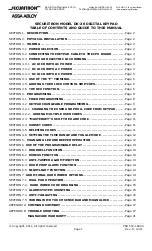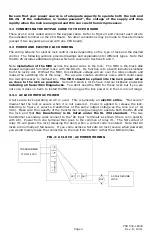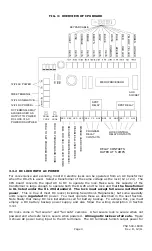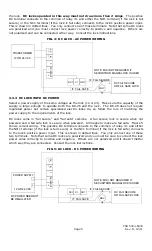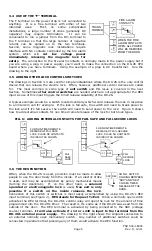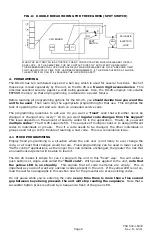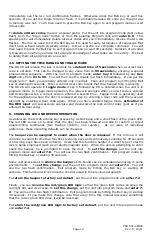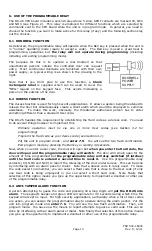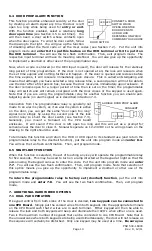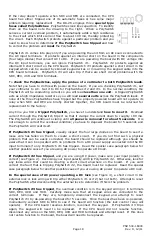
PN# 500-16900
Page 11
Rev. D, 12/11
program additional User codes, you follow the procedures described above for setting the User
code in memory location 01 but you employ memory locations 02 through 59. For example,
once the unit is in program mode (rapid yellow flash), entering 0-2 followed by a code sequence
will enter a second User code. The same is true when you enter prefixes 0-3, 0-4 up to 5-9.
When you’re programming multiple User codes, note that you can enter them one right after
another. When a code is accepted, the unit signals by two red flashes. It then automatically
goes back into program mode and another code can be immediately entered without exiting
program mode. Be sure to test all the codes you have entered before you consider
programming complete. You can individually erase any code (including the Program code) by
entering program mode, pressing the prefix for the code (01-59) and then pressing the Bell key
or waiting 5 seconds until you get the two red flashes.
4.3 “MASTERKEY” USE OF THE HARD CODE
The primary use for the Hard code is to allow simple single code “fixed” operation as is described
in Section 4.1. The Hard code can only be set or changed from the “Hard Code” button in the
CPU board. It is deliberately kept separate from all programming functions. Another use for it,
however, is as a “masterkey” code. For example, consider a facility with multiple DK-26’s under
the control of different departments. Each department might want to employ different Program
and User codes to restrict cross access but a common Hard code could be established for all of
the units so that security management personnel could enjoy universal access. This Hard code
will never be lost from keypad operations (the CPU board has to be accessed).
4.4 SUBSET CODES
When you recognize that the DK-26 accepts multiple codes of different lengths, it is possible
that one code will be a subset of another. For example, suppose you programmed “1-3-3-5-8”
and then programmed “3-3-5” as another code. When you try to enter 1-3-3-5-8, you can’t
complete the entry because when the unit sees the sequence 3-3-5, it will operate. A real
problem could occur if a User code was a subset of the Program code. The unit could not be put
into program mode from the keypad.
The DK-26, however, avoids this problem by rejecting any code that is a subset of another
code in memory. It signals this rejection by showing the single red (error) flash instead of the
two-flash confirmation signal. You’ll get the same error if you try to enter a duplicate code. If
you are trying to enter a code and see it rejected by the error signal, carefully check your list of
other codes. You are probably attempting to enter a subset code. If the security procedures of
the installation allow individuals to choose their own codes without reference to a list, the users
need to be advised that they may have to try alternate codes if the one they prefer is rejected
as a subset. Other typical reasons for code rejection are covered in the troubleshooting section
at the end of the manual.
4.5 DELETING CODES
To delete the Hard code, press the “Hard Code” button on the CPU board, confirm that you are
in hard program mode (slow yellow flash) and press the Bell key or wait 30 seconds.
To delete the Program code, put the unit into program mode (fast yellow flash) from the
“Prgm Code” button or from the existing Program code. Enter 0-0 and press the Bell key or wait
five seconds. You’ll see the two red confirmation flashes. You’ll need to then press the Bell key
again to exit program mode or wait 30 seconds. Note that it can be considered logical to
operate without a Program code. It is more difficult to put the unit into program mode (it can
only be done from the “Prgm Code” button in the CPU board) but User codes can still be changed
and some users may feel that this is a more secure code changing procedure.
To delete any individual User code, put the unit into program mode (fast yellow flash) from
the “Prgm Code” button or from the existing Program code. Enter the prefix for the code you
wish to delete (01 - 59) and press the Bell key or wait five seconds. You’ll see the two red
flashes. You’ll then need to press the Bell key again to exit program mode or wait 30 seconds.
An alternate method to delete any individual User code when you know the actual code
but not the two digit prefix is as follows. Put the unit into program mode (fast yellow flash)
from the “Prgm Code” button or from the existing Program code. Enter 7-9 followed
immediately by the complete code you wish to delete. If it’s a seven digit code you’ll
Summary of Contents for Securitron DK-26
Page 23: ......


